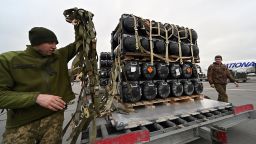The US believes that Russia is learning from its failures in the north of Ukraine, where they did not have the proper capabilities to sustain military operations, and applying those lessons to their new focus in the east and the south of the country, according to a senior US defense official.
“What we have seen over the last few days is them continue to try to set the conditions,” the senior defense official said in a call with reporters on Monday. “We call it shaping operations.”
“It appears as if they are trying to learn from the failed lessons of the north where they didn’t have proper sustainment capabilities in the area they were about to operate,” the official said.
The official said that the US has seen Russia moving in “heavy artillery,” “command and control enablers” and “aviation, particularly rotary aviation support” as part of the 11 new battalion tactical groups that have moved into the east and south of Ukraine “over the last few days.”
Russia is massing troops and appears close to taking the southeastern port city of Mariupol. CNN reported on Monday that the fate of Mariupol is hanging on an unknown number of defenders making their last stand at an iron and steel plant.
Heavy fighting was still going on in the city on Monday, according to Petro Andriushchenko, an adviser to the city’s mayor.
Later on Monday Andriy Yermak, head of the Office of the President of Ukraine, said the “second phase of the war” had begun in the eastern Donbas region, amid clear signs of a stepped-up Russian offensive.
Ukrainian President Volodymyr Zelensky confirmed the battle for Donbas had begun in a video address on Monday.
“Russian forces have started the battle for Donbas for which they’ve been preparing for a long time and a considerable amount of the Russian forces are concentrated and focused on that offensive,” Zelensky said.
He underscored that Ukrainian forces will continue to fight against a Russian incursion in the region.
“No matter how many Russian servicemen they’re bringing into that area, we will keep on fighting and defending and we will be doing this daily. We will not give up anything that is Ukrainian but we don’t need anything that is not ours,” Zelensky said.
“I’m thankful to all of our warriors, our soldiers, our heroic towns and towns in the region who are resisting and standing firm,” he said.
Russia’s disjointed — and at times chaotic — operation in the north of Ukraine has been well-documented and their early military failures largely came as a surprise to US and western officials.
Since Russia launched its assault on Ukraine on February 24, it has bombarded Ukrainian cities with missiles and artillery, destroying apartments, hospitals and schools and leaving scores of civilians dead. But its ground invasion has largely stalled and Moscow has failed to seize key cities, including Kyiv, amid fierce resistance from the Ukrainians and what senior defense officials have described as tactical errors.
Russia focusing on east and south
The US assesses that Russia has added 11 battalion tactical groups (BTGs) to their forces in the east and south since late last week, according to the senior US defense official, bringing Russia’s total number of BTGs to 76.
“They have added to their capability inside Ukraine,” the official said.
The official said that all Russian ground forces are currently focused in the east and south of Ukraine, but the US is unable to pinpoint exactly how the new BTGs are spread out.
In preparation for a new type of fight on the open plains of southeast Ukraine right next to Russia, the US is providing Kyiv with the types of high-power capabilities some Biden administration officials viewed as too much of an escalation risk a few short weeks ago.
The new, $800 million weapons package represents the starkest sign to date that the war in Ukraine is shifting – and with it, the weapons Ukraine will need if it hopes to continue to stymie a Russian military that has regrouped and resupplied after its initial failures in the opening weeks of the war.
The Biden administration announced that the new package included 11 Mi-17 helicopters that had initially been earmarked for Afghanistan, 18 155 mm Howitzer cannons and 300 more Switchblade drones, in addition to radar systems capable of tracking incoming fire and pinpointing its origin.
This package stands out from previous security assistance in part because this tranche includes more sophisticated and heavier-duty weaponry than previous shipments.
A US official told CNN last week that’s by design, arguing that because Russia, which was unable to capture Kyiv, has shifted its strategy to concentrate forces in eastern Ukraine, the US is shifting its own strategy in what it gives Ukraine.
“The contours of what they need is very different,” the US official said.
Several of the weapons systems are complex enough that the Pentagon has said it will need to provide training for Ukrainians outside the country, as was previously provided for the Switchblade drones, with the senior defense official saying that training on the Howitzers will begin “in the next several days.”
“We’ll try to get opportunities for a small number of Ukrainians to be familiarized with these systems,” said Pentagon Press Secretary John Kirby at a briefing with reporters last week, “but we don’t believe that it’s going to be an onerous task or lengthy in time or in resources.”
This story has been updated with comments from Ukrainian President Volodymyr Zelensky.
CNN’s Nathan Hodge, Kostan Nechyporenko, Oren Liebermann, Jeremy Herb and Kaitlan Collins contributed to this report.








